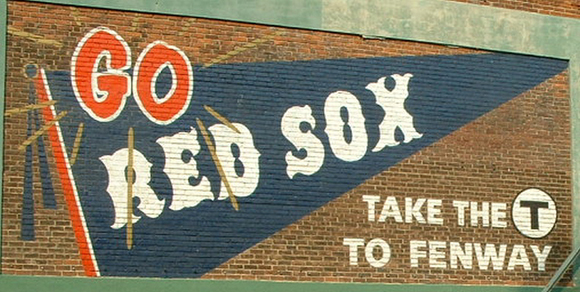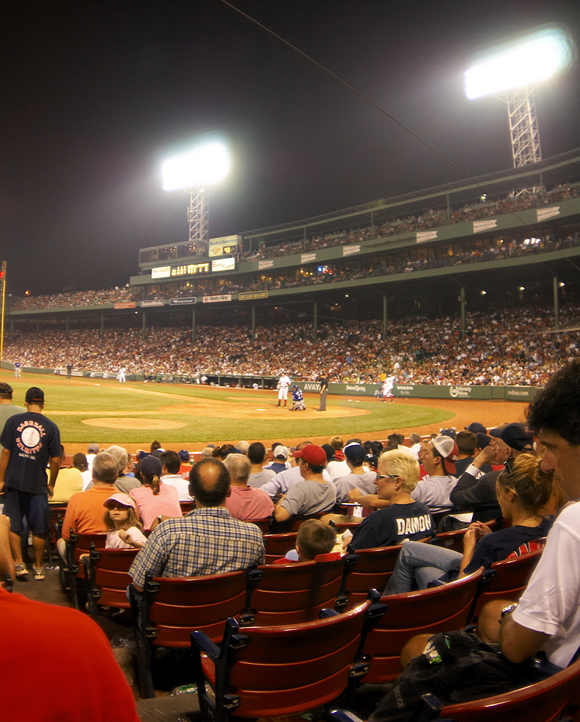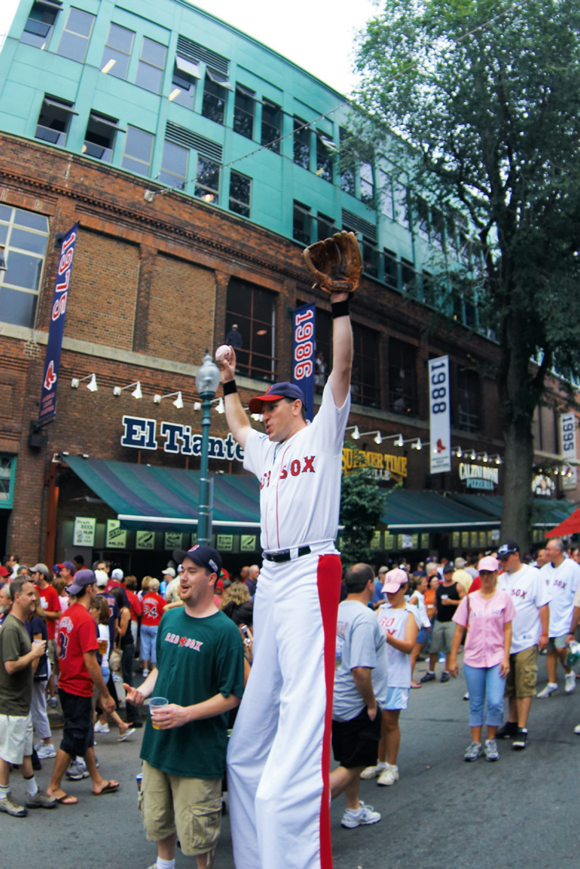It’s not every day when an icon manages to meet your expectations, never mind exceed them. But Fenway Park, the Mecca for everyone interested in balkparks on any level, not only meets expectations but shatters them. It is true that at Fenway the grass is greener, the hot dogs are tastier, and the fans more passionate than any other park in major-league baseball.
FAST FACTS
Year Opened: 1912
Capacity: 38,805
Dimensions: 304L, 379LC, 420C, 380RC, 302R
Playing Surface: Grass
Website: redsox.com
Telephone: 617/267-1700
League: American League
Ticket Prices: Field Box, $125; Loge Box, $90; Infield Grandstand, $50; Right Field Box, $50; Right Field Roof Box, $50; Outfield Grandstand, $30; Right Field Roof Box Standing Room, $30; Bleachers, $26; Pavilion Standing Room, $25; Standing Room, $20 Parking: There’s a surprising amount of parking available in the area, although most of it is expensive ($25-$50).
Address/Directions: 4 Yawkey Way, Boston. The stadium is in the Fens area of Boston, west of the Back Bay. If you’re taking the T, jump on the Green Line and get off at the Kenmore Square stop; the ballpark is a short walk away. (We’d highly recommend taking the T.) If you’re driving, get onto Storrow Drive (this seems to apply no matter where you’re coming from) and take the Fenway Park.
The only other park in baseball that compares to Fenway is Wrigley Field: they are both born of the same era, even though they have their own distinctive looks. But one important thing they share: they look like they have belonged in their current locations. But while Wrigley springs organically from the corner of Clark and Addison, Fenway Park is hunkered in The Fens, not really dominating its neighborhood (from the outside, it looks much smaller than it really is) like Wrigley does. Of course, it doesn’t have to: while there is a small neighborhood that’s sprung up around Fenway Park, it resides in a bustling commercial area. It’s a good fit: when the workers leave for the day, Red Sox fans can then swarm into the area.
In many ways Fenway Park is the antithesis of the new retro ballparks that try to emulate the feel of Fenway. Whereas a Safeco Field will have a cohesive look that ties together the various sections of the ballpark, Fenway Park looks and feels like it evolved gradually over the years — which was the case. Just look at the picture to the left: any architect who would set out to design that weird set of bleacher jutting out from the Green Monster in center field would be hooted by his peers for the offense of studied mannerism. That same trait in Fenway Park is just endearing. And the fans at Fenway Park yell louder than the fans at most retro parks. Seattle fans tend to be polite to a fault, and the regulars at AT&T Park spend as much time on their cell phones as they do watching the game. But the fans at Boston are eagle-eyed and truly involved in the game. There’s a palpable buzz when a fan favorite like Dustin Pedroia comes to the plate: play hard in Boston and the Fenway regulars will love you. That’s part of the Fenway tradition.
And that Fenway tradition is important, because watching a game at Fenway can be a most physically uncomfortable experience. Yes, the narrow seats are crammed together and the aisles are narrow, so you had better be ready to cozy up to the folks sitting next to you. Sitting down the right-field line? Be prepared to fight the sun for the first few innings. (Here’s your first insiders’ tip: don’t buy a seat down the right-field line. The bleacher seats are cheaper and are positioned directly toward the plate.)
Speaking of choosing where to sit: sometimes you won’t have any choice and you’ll need to be happy just being in the ballpark. Good seats are really hard to come by unless you know a season-ticket holder, are willing to sit in the bleachers (which are vastly underrated), know you’ll pay through the nose through a scalper, or buy your tickets when they first go on sale. I was lucky: attending a game alone, I managed to score a pretty decent seat in a loge box, looking directly down the third-base line. This gave me a great perspective when David Ortiz slammed a home run into the new seats atop the Green Monster — this ballpark is so intimate that it felt like I could reach out and grab that homer myself. (By the way, those primo seats on the Green Monster are sold only at the ticket office and are not offered online.)
Once you have a ticket, you owe it to yourself to get the ballpark early. Spend some time walking around the outside of the stadium, as it has remained relatively unchanged since its construction. The original entrance to the stadium has the original “FENWAY PARK” sign above it, and there are a host of windows and doors that look as though they’ve not been opened in 70 or so years. If you walk over to Gate C, you can see where a deck was added to the top of the Green Monster. Walking around the stadium takes a little longer than you’ll anticipate: for such a small stadium, Fenway Park sure does seem to eat up a good amount of space, as there are a lot of things — like a parking garage past the center-field bleachers — that the average fan never sees. Drop by the Boston Beer Works (61 Brooklyn Av.) across from the Red Sox ticket office for a Fenway Ale to rest your feet after navigating the park.
After you’re done inspecting the exterior of Fenway Park, go ahead and spend some time on Yawkey Way. The Red Sox fought local businesses for the right to close down Yawkey Way before the start of home games, but the fight was worth it: the street closing gives folks a fun place to wander around before games and adds a festive atmosphere to the evening. For the most part the concession offerings match those found in the ballpark, but they also add some unique foodstuffs (which we’ll discuss under Concessions). Once inside the turnstiles you can check out the original ticket booths to the stadium, a plaque honoring the renovation of Fenway Park in 1934 and a display on how bats and gloves are made (including a lathe where bats are actually turned). Players enter the stadium on the far end of Yawkey Way: if you are there really early you can snare an autograph or two as they walk in.
The Red Sox owners are forever trying to maximize revenues from Fenway Park (mostly to pay off the $700 million they paid for the club, the stadium and the NESN network). Recent additions have included rooftop seats and bar-type seats on the top of the Green Monster. These additions were done very tastefully: both of them look like they really do belong at Fenway Park. This sensitivity to the Fenway Park aesthetic does speak well of Red Sox management and how they might approach other changes to Fenway.
But the big issue is how Fenway Park will fare over the next ten years. Red Sox management openly complains about the small size of the park and the lack of luxury suites. But these complaints are really a red herring: the team draws very well even while charging some of the highest prices in the majors, and the combination of the Red Sox and NESN is a cash cow for the team owners. In the end, it’s highly doubtful that the Red Sox will ever move from Fenway Park: it is truly a national treasure and a Boston landmark, and in a city where change occurs slowly, it’s unimaginable that Boston would ever allow the construction of a replacement stadium.
When it was built, Fenway Park (so named because of its location in the Fens section of Boston) wasn’t even the largest ballpark in Boston — Braves Field, home of the Boston Braves (forerunners of the Milwaukee Braves and the Atlanta Braves) sat 42,000, and occasionally the Red Sox would rent Braves Field when large crowds were anticipated, such as games 3 and 4 of the 1915 World Series.
Though Fenway Park’s basic configuration has remained unchanged since it opened, there have been several alterations and improvements over the years. The Green Monster — the huge wall in left field — was there in one form or another since the opening of Fenway Park, but it featured large advertisements until 1947, and originally there was a 10-foot embankment in the front where fans could sit. This mound was called Duffy’s Cliff, named so for a Red Sox player named Duffy Lewis. (By the way, the ladder on the Green Monster is in play.) This is the third incarnation of the Green Monster: the original was a 25-foot-high wall, which burned down in 1934 (more on that in a second), the second was a 37-foot-high wall made of tin stretched over railroad ties, and the current Green Monster plastic wall was built in 1976. A series of fires ended up dictating changes in Fenway over the years. Originally there were wood bleachers down the left field line, but these were burned down on May 8, 1926, and for many years the team merely cleared away the area, leaving a huge foul territory. Another fire on Jan. 5, 1934, led to all the wooden grandstands being replaced with concrete and steel. At that time capacity at Fenway was increased from 27,642 to 33,817. Two years later the net was added above the Green Monster to prevent home runs from landing on nearly Lansdowne Street.
The bullpens, known as Williamsburg because of all the long flies hit by Ted Williams, were originally in fair territory in right field until 1940, when the fences were moved in and the bullpens moved behind the fence. The scoreboard is still a manual scoreboard.
There were roof boxes built in 1942, but true luxury boxes didn’t make an appearance at Fenway until 1983, and another premium seating area, the 600 Club, was added in 1988. The 600 Club was removed prior to the 2006 season, replaced by the open-air EMC Club.
Other teams that called Fenway Park home include the Boston Braves (who played a World Series there in 1914), the Boston (later New England) Patriots, and the Boston Redskins, an NFL team that later became the Washington Redskins.
CONCESSIONS
Red Sox management continually expresses displeasure with the state of concessions at Fenway Park, saying that the concourse is too cramped and prevents fans from spending more on food and drink.
That’s hogwash.
There is a ton of concourse space at Fenway Park, and the Red Sox have crammed it with every sort of concession stand imaginable. Especially spacious is the concession space past the outfield bleachers, where there’s plenty of room for an abundance of concessions stands, a set of picnic tables and enough stand for hundreds to mill around. (If the Red Sox were truly concerned about the clutter, they’d shut down a concession stand or a credit-card hawker and give folks even more room to walk about.) This area was once filled with television trucks, but the Red Sox cleared them out before the beginning of the 2003 season and installed what team management calls the most spacious restrooms in the major leagues.
As a result, you’re never too far away from a concession stand at Fenway Park. The vast majority of them focus on the staples. Don’t leave the park without downing a Fenway Frank ($3.50), surely one of the best hot dogs served at a ballpark. Yes, the franks are boiled, but hot dog does not meet white-bread bun (and in Fenway, the buns aren’t your standard hot-dog bun, but soft split-top white bread buns) until you order your Fenway Frank. The result? Delicious — about as delicious as highly processed food ever gets. Almost as good: the $4.75 Italian sausage with peppers.
You’ll want to down that hot dog with a beverage. There’s actually a fairly limited number of beers available, with Bud Light, Miller Lite and Coors Light on tap for $4.95, and Amstel Light and local brew Sam Adams on tap for $6.25.
There are some unique offerings if you take the time to look. Variations on the Fenway Frank include the $5 Boston Dog (served with cheese and chili) and the $5 New York dog (served with sauerkraut). If you want your meat a little purer, check out the Hilltop Steak House, where the steak-tips sub goes for $6. You can go native with the Legal Sea Foods clam chowder ($5). When you’re ready for dessert, there’s the Hood’s ice cream cone ($3.50) or that New England staple, fried dough ($4.75). This isn’t the greatest variety we’ve seen at a major-league ballpark, but let’s be real: after a Fenway Frank and a brew, you really don’t need a whole lot more.
If your tastes run to the more pedestrian, there are stands serving nachos, peanuts, Jr. Gino pizza, soda and popcorn.
Even more variety can be found out on Yawkey Way, which is closed to traffic an hour before game time. Most of what’s found inside the stadium, like Fenway Franks, can be found on Yawkey Way. In addition to beers mentioned above, you can find Harpoon IPA on tap for $4.75 and Presidente in the bottle. There are sandwiches of all sorts: $7.75 Cuban sandwiches at the El Tiante booth, BBQ beef sandwiches for $7.75 and chicken cheese steak sandwiches for $6.25. And don’t forget the Italian ice or the fresh-roasted peanuts served by the paper bag, a bargain at $4. On a hot night, standing on the asphalt on Yawkey Way isn’t the most fun, of course, but later in the evening it’s a pleasant place to take a short break from the action.



